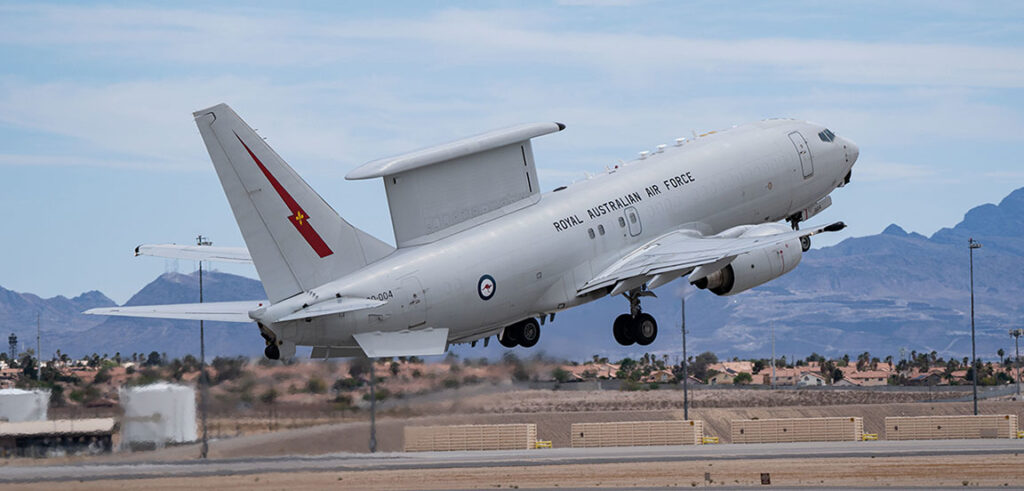A Royal Australian Air Force E-7A Wedgetail takes off during Black Flag 22-1 at Nellis Air Force Base, Nevada, on May 10, 2022. The E-7A Wedgetail is equipped with high-powered radar and is used to monitor the battle space and provide friendly forces with an advantage over their opponents. It is the type of early warning aircraft being considered by the Canadian government. AIRMAN 1ST CLASS JOSEY BLADES/U.S. AIR FORCE
THE WATCH STAFF
Canada plans to spend $3.65 billion to purchase advanced early warning aircraft, officials confirmed to Aviation Week, an aerospace industry news magazine. The plans to upgrade Canada’s long-range threat detection capabilities was announced in the country’s new defense strategy — Our North, Strong and Free — in April 2024. The new planes will improve North American homeland defense and provide increased interoperability and coordination with the United States.
The Canadian government didn’t announce which type of advanced early warning aircraft it would purchase, but the United Kingdom recently spent $2.33 billion for three Boeing E-7 Wedgetail planes. The U.S. Air Force is already replacing the E-3 Sentry, its long-serving advanced early warning plane, with the E-7, according to Aviation Week. Canada framed the intended purchases of advanced early warning aircraft as part of its commitment to the North American Aerospace Defense Command (NORAD).
“To detect and manage airborne threats, we will acquire airborne early warning aircraft. These aircraft detect aircraft and missiles at long ranges in real time and from much further away than ground-based radars, and then manage the battle space in response to a threat. They will vastly improve the Royal Canadian Air Force’s ability to detect, track and prioritize airborne threats sooner, respond faster, and better coordinate our response with the United States when required. They will allow Canada to continue making meaningful contributions to NORAD while also supporting allies and partners globally,” states the 36-page strategy released by the Canadian government in April 2024.
The Royal Canadian Air Force is familiar with Boeing advanced early warning aircraft. Canada provides crews and personnel to NATO’s Germany-based E-3 Sentry force, and the Canadian Armed Forces (CAF) routinely work with E-3s in their NORAD operations. Australia, one of the Five Eyes partners along with the U.S., U.K., Canada and New Zealand, already flies the E-7.
Canada’s new defense policy, which expands upon the 2017 defense policy, prioritizes the Arctic region and northern territories. “Climate change is rapidly reshaping Canada and reshaping our North,” Prime Minister Justin Trudeau said in a televised news conference from Canadian Forces Base Trenton, Ontario, according to Defense News, an online news site focused on military issues. The policy notes that the melting of Arctic ice is “making a vast and sensitive region more accessible to foreign actors who have growing capabilities and regional military ambitions.”
The new defense policy increases defense spending from $22 billion to $36 billion by 2029 and includes new tactical helicopters and long-range missiles for the Army. Specialized maritime sensors will also be purchased to deepen detection capabilities. In addition, new satellite communications systems will be acquired, and cyber operations capabilities will be expanded. With a focus on the Arctic, the Canadian military will establish support hubs in the Far North. A new satellite ground station will also be built in the Arctic, Defense News reports.

